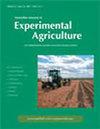Reduced space allowance for adult sheep in lairage for 24hours limits lying behaviour but not drinking behaviour
引用次数: 9
Abstract
The key lairage requirements for livestock include sufficient space to lie down, sufficient time to allow recovery from travel, and access to water to allow recovery from dehydration. Current recommendations for lairage of adult sheep include that holding pens should provide no less space than 0.6 m2 per sheep. Particularly during periods when large numbers of sheep are culled, space allowances may be limited to 0.3 m2 or less, which may reduce the ability of individual sheep to lie down or access water. Adult Merino-cross sheep were allocated to one of four space allowance treatments during unloading from commercial transport vehicles at a commercial abattoir after an average transport time of 3 h. The treatments were 0.3, 0.45, 0.6 and 1.0 m2/sheep and each pen measured 18 m2. Differences in space allowance were achieved by varying the number of sheep per pen, with pens holding 18 (1 m2), 30 (0.6 m2), 40 (0.45 m2) and 60 (0.3 m2) animals. In each pen, eight focal sheep were randomly selected and marked on the back for identification on video records. The sheep remained in the lairage treatments for 24 h and were continuously recorded on video using low light cameras. The data were subsequently analysed for both lying and drinking behaviours after 8 and 24 h in lairage. There were five replicates of all treatments over a 3-week period. A space allowance of 0.3 m2/sheep reduced the time sheep spent lying and the proportion of sheep that lay down at least once, compared with greater space allowances. Space allowances between 0.3 and 1 m2/sheep showed a linear relationship with the time sheep spent lying during the first 24 h. Optimal space allowance may be greater than 1 m2, based on lying behaviour. Drinking behaviour was not affected by space allowance in a 24 h period in lairage although overall 20% of sheep were not observed to drink after 24 h in lairage.成年羊在饲养场24小时内的空间减少,限制了它们的躺卧行为,但不限制它们的饮水行为
对牲畜的主要饲养要求包括有足够的空间躺下,有足够的时间从旅行中恢复,有足够的水从脱水中恢复。目前对成年羊放养的建议包括,每只羊的围栏空间不少于0.6平方米。特别是在大量羊被扑杀期间,空间可能限制在0.3平方米或更小,这可能会降低单个羊躺下或取水的能力。在平均运输时间为3小时后,在商业屠宰场从商业运输车辆卸载时,将成年美利奴杂交羊分配到四种空间补贴处理中的一种。处理分别为0.3、0.45、0.6和1.0 m2/羊,每圈18 m2。通过改变每个羊圈的羊数来实现空间的差异,羊圈可以容纳18只(1 m2)、30只(0.6 m2)、40只(0.45 m2)和60只(0.3 m2)的羊。在每个围栏中,随机选择8只焦点羊,并在背面标记,以便在视频记录中识别。放养处理24 h后,用弱光摄像机连续录像。随后,研究人员对8小时和24小时后的撒谎和饮酒行为进行了分析。所有处理在3周内进行5次重复。与更大的空间相比,0.3 m2/只羊的空间允许减少了羊躺卧的时间和至少躺一次的羊的比例。0.3 ~ 1 m2/羊的空间余量与羊在头24 h内的躺卧时间呈线性关系。根据躺卧的行为,最佳空间允许可能大于1平方米。在24小时的圈养期间,尽管总体上20%的羊在24小时的圈养后没有观察到喝水,但饮水行为不受空间限制的影响。
本文章由计算机程序翻译,如有差异,请以英文原文为准。
求助全文
约1分钟内获得全文
求助全文

 求助内容:
求助内容: 应助结果提醒方式:
应助结果提醒方式:


